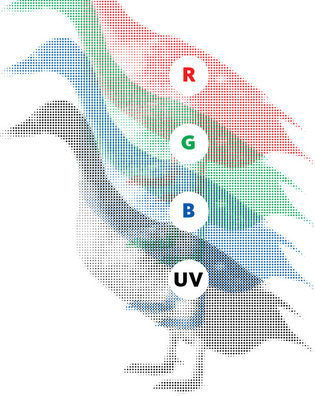 loading
loading
FindingsBird's-eye viewThe crazy colors birds can see.  Mark Zurolo ’01MFAThe four types of cones in bird's eyes enable them to see red, green, and blue light—plus ultraviolet colors many animals can't see at all. View full image
To human eyes, birds have the color spectrum covered. From the pigeon and sparrow to the painted bunting and scarlet macaw, birds have evolved a stunning palette for communication, camouflage, and other purposes. It’s a color scheme even broader than most people realize, because birds sport many hues that are invisible to humans. But from a bird’s-eye view, the show is fairly drab. New research demonstrates that many of the colors birds can perceive never show up on their plumage at all. Humans, along with many of our primate relatives, can’t see in the ultraviolet range. Our eyes have three types of color-perception cone cells, and together they are capable of picking up light in the red-green-blue range—what we call the “visible” part of the color spectrum. Birds, however, have four color-cone types. They see everything we can see, plus ultraviolet colors we can’t. Yale ornithologist Richard Prum and Mary Caswell Stoddard ’08, who worked in his lab and is now a Marshall Scholar at the University of Cambridge, recently completed one of the most comprehensive analyses of plumage coloration ever undertaken. Using 965 feather patches from a representative sample of 111 bird species, all from the collection of Yale’s Peabody Museum, they measured the characteristics of the light reflected by each patch to identify the entire array of avian hues. (The work appeared in Behavioral Ecology.) Those hues can come either from pigments or from microscopic structures that affect light wavelengths. It’s the latter that produce the colors of blue jays and peacocks—and allow some birds to grow ultraviolet feathers. But when Prum and Stoddard analyzed their findings using a mathematical model of all the colors visible to birds, they discovered vast empty spaces. Only 26 to 30 percent of the colors actually existed in the feather sample. “As near as we know, birds don’t produce many ultraviolet-plus-green, deep purple, or ultraviolet-plus-red colors,” says Stoddard. There are two possible reasons for the discrepancy, she suggests. The first, known as the “blue rose hypothesis,” holds that some colors, like a true blue in roses, may simply be difficult or impossible for birds’ physiology to manufacture. The other Stoddard dubs the “nosebleed section hypothesis,” in honor of the undesirable seats at the top of a stadium: “It’s possible to go there, but it’s not ideal. Some colors are just not advantageous for a bird to produce, so there’s no incentive to make them.” But the avian rainbow has increased over evolutionary time—the ability to bend light with nanostructures is relatively recent—and, since birds have so much perceptual capacity in reserve, their palette could continue to grow. “The jury is still out on where bird colors will go next,” says Stoddard. “That’s what makes it so intriguing.”
The comment period has expired.
|
|